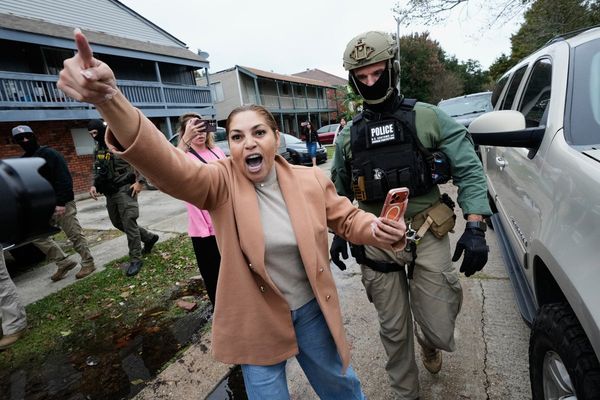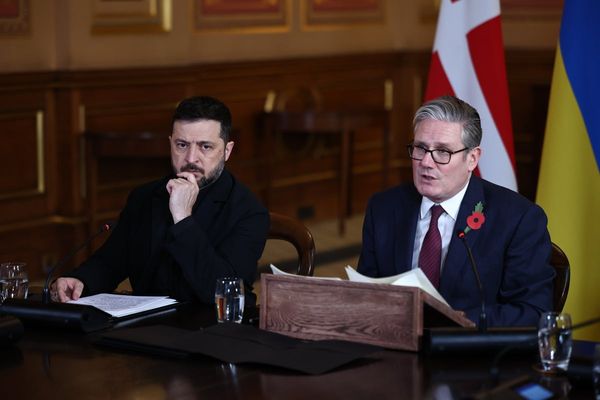
Kristi Noem, the homeland security secretary, and Gregory Bovino, a border patrol sector chief, were seen at an Ice facility in suburban Chicago on Friday where law enforcement has been cracking down on protesters.
In recent weeks the Broadview facility has become the site of escalations by federal agents against protesters and journalists. Videos of agents deploying tear gas, pepper balls and roughly throwing protesters to the ground have gone viral, amidst the Trump administration’s immigration crackdown.
The Trump administration targeted Chicago with federal law enforcement starting in August, falsely claiming there had been a rise in crime in the city in recent years. Since then, there have been increasingly aggressive reports of Ice enforcement in communities, including helicopters hovering over apartment raids. There have also been arrests of local officials and candidates for office who were protesting, including Illinois’ ninth congressional district Kat Abughazaleh, who went viral with a video of an Ice agent slamming her to the ground, Daniel Biss, the Evanston mayor, and a city alderman who were aggressively arrested while trying to advocate in a hospital setting.
In Broadview, several people were arrested early Friday morning, after Ice along with Illinois state police, the Cook county sheriff’s office and other local law enforcement arrested and shoved protesters gathered for a weekly demonstration.
A local cabinet-making business, adjacent to the Broadview Ice processing facility, has had tear gas seep into their warehouse and workers hit by pepper balls, according to the Chicago Sun-Times.
On Thursday, a group of Illinois law enforcement agencies, including the Broadview police department had announced they were forming a unified command to “enable the peaceful expression of the first amendment”, as well as ensure that local businesses and people in Broadview were kept safe, according to a press release. The statement also said: “The agencies involved in this operation will neither assist nor obstruct enforcement of federal immigration statutes in compliance with state and federal law.”
Broadview, the mostly Black, working-class suburb of around 8,000 people, has become a flashpoint in what the Department of Homeland Security has deemed “Operation Midway Blitz.” There aren’t any figures publicly available for how many people are detained at the Broadview facility, which is not staffed or intended to be run as a detention center.
In the state of Illinois, almost 5,000 people have been detained this year, according to data from The Deportation Data Project and analyzed by the Chicago Sun-Times.
For the people detained inside the facility, they describe not receiving adequate food or water, and having to use the bathroom in public. One person described to a Chicago Sun-Times reporter, not having soap or toothpaste and dealing with severely overcrowded conditions.
Katrina Thompson, the Broadview mayor who has been in office in since 2017, said in a letter to DHS that Ice agents were “making war in our community”, last Friday, and in response the agency warned there would be a “s—t show” in Broadview.
The treatment of protesters and journalists has drawn attention to Broadview.
One protester, named A’keisha who declined to share her last name, said that it seemed like Ice agents wanted to hurt protesters.
“What was unique on the first day is that it didn’t feel like Ice had planned to use their legal tools to remove us,” she said. “They have the right, right to say, ‘Y’all gotta leave, arrest them.’ But they didn’t. They chose instead to be violent and, like, push us and throw us to the ground and drag us.”
A’keisha has been involved in faith-based movements to end mass incarceration for years and has organized against militarization for almost a decade. She said she was moved to join protests because of her Haitian heritage and solidarity with immigrant communities.
Another protester, Reverand David Black of the First Presbyterian church of Chicago, said that he was pelted with about seven or eight “pepper exploding pellets” that hit his head, face, torso, arms and legs, while in a position of prayer.
“I’m not a political ideologue, but I am very deeply rooted in my faith, in the ways that it calls me to show up in this moment as someone who can proclaim the good news and call these Ice agents into their right mind,” he said.
Local journalists have been detained or attacked by federal agents as well. Over the weekend, Steve Held, Unraveled Press co-founder and reporter, was detained by agents while covering a protest outside of the facility. A Chicago-Sun Times reporter was also tear-gassed and pelted with “rubber projectiles”, according to the outlet.
On Sunday morning, CBS Chicago News reporter Asal Rezaei, was attacked by an Ice agent who shot a pepper ball into her car from about 50ft away and was exposed to chemicals on her face. She said in a social media post that after the incident, she was “puking for two hours”.
In addition to protesters and journalists, legal observers, often delineated in the Chicago-land area by their bright neon green hats that read “legal observer” were also attacked in recent weeks by Ice agents.
“There has been an extreme escalation in the use of force by federal agents at that facility against people who are exercising their first amendment rights, and targeted attacks against members of the press and legal observers with The National Lawyers Guild,” said Molly Armour, a volunteer attorney with the National Lawyers Guild Chicago for over 15 years.
What was most troubling about the behavior of federal agents at Broadview for her, Armour said, was the use of “violent military-style offensive weaponry used against people, such as tear gas canisters, [and] different kinds of aerosol chemical agents”, particularly against people just observing what’s going on.







